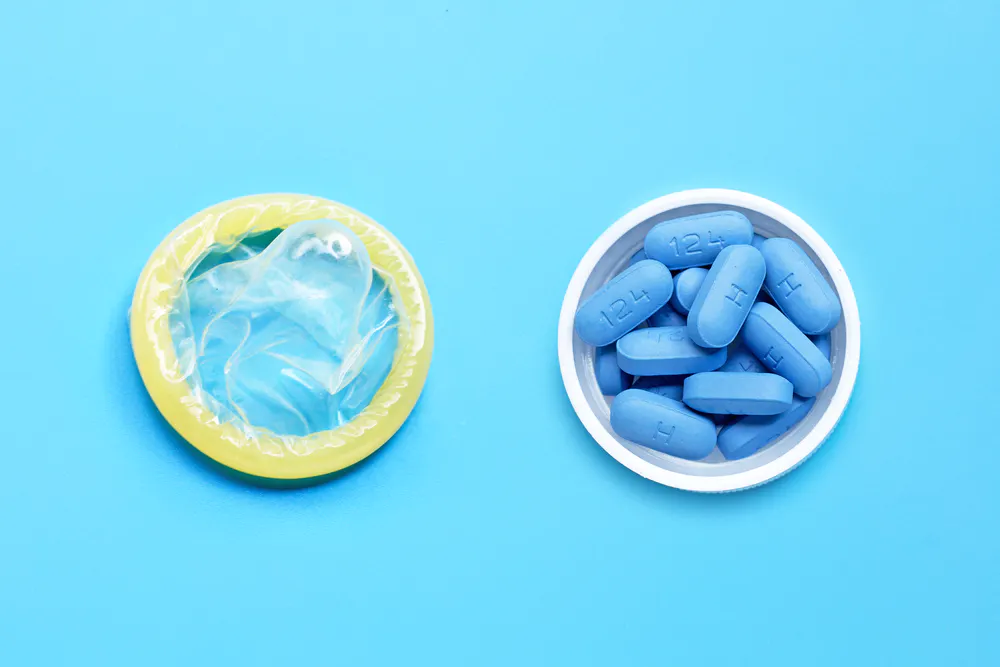Addressing HIV Transmission: Examining Condoms and PrEP for Protection
Concerns surrounding HIV transmission loom large for sexually active individuals, particularly those engaging in high-risk behaviors. Fortunately, several avenues exist to safeguard against HIV, with condoms and pre-exposure prophylaxis (PrEP) being notable choices. Nevertheless, confusion often arises regarding the relative effectiveness of these methods in preventing HIV transmission. In this article, we delve into the disparities between PrEP and condoms, aiming to illuminate which approach might be more suitable for you. Our discussion encompasses the mechanics of HIV transmission, the imperative of shielding oneself from the virus, as well as an exploration of the purpose and efficacy of condoms and PrEP.

Understanding the Mechanisms of HIV Transmission
HIV, an infection that targets the immune system, renders individuals vulnerable to various infections and illnesses. The transmission of HIV primarily occurs through bodily fluids, including blood, semen, vaginal fluid, anal fluid, and breast milk. Sexual contact, mother-to-child transmission during pregnancy, childbirth, or breastfeeding, as well as the sharing of needles or other drug injection equipment, serve as the key avenues through which HIV is transmitted.
What measures can be taken to protect against the transmission of HIV?
To safeguard against HIV transmission, there are several key strategies that can be followed:
- Practice safe sex: Engage in sexual activities with a mutually monogamous, uninfected partner or consistently and correctly use condoms during every sexual encounter, especially if you or your partner’s HIV status is unknown.
- Get tested and know your status: Regularly undergo HIV testing to be aware of your own HIV status and encourage your partner(s) to do the same. This promotes early detection and timely access to treatment if needed.
- Consider pre-exposure prophylaxis (PrEP): If you are at a higher risk of HIV infection, such as having a partner with HIV or engaging in high-risk behaviors, consult a healthcare professional about PrEP. PrEP involves taking medication daily to significantly reduce the risk of contracting HIV.
- Use clean needles: If you inject drugs, always use clean needles and syringes. Additionally, consider seeking support for substance abuse and exploring harm reduction programs.
- Practice universal precautions: Healthcare workers should adhere to universal precautions, such as wearing gloves, using protective barriers, and safely disposing of sharps, to minimize the risk of exposure to HIV and other bloodborne pathogens.
- Prevent mother-to-child transmission: Pregnant women living with HIV should seek appropriate medical care and follow the recommended treatment to prevent transmitting the virus to their child during pregnancy, childbirth, or breastfeeding.
- Education and awareness: Stay informed about HIV transmission, prevention methods, and related issues. Educate yourself and others to dispel myths, reduce stigma, and promote responsible behavior.
What are the common causes or factors associated with HIV?
HIV is primarily linked to certain behaviors or actions that heighten the risk of transmission. The predominant modes of HIV transmission include engaging in sexual contact and sharing needles or equipment for drug injection.
What are the factors that can heighten the risk of HIV transmission?
Several factors contribute to an increased risk of contracting HIV. Here are some of the most prevalent ones:
- Engaging in unprotected sex, particularly anal intercourse, with multiple partners.
- Sharing needles and other drug injection equipment, which can expose individuals to infected blood.
- Having a sexually transmitted infection like gonorrhea, chlamydia, or syphilis, as these infections can facilitate HIV transmission.
- Having open sores or cuts on the body, as they provide entry points for the virus.
- Receiving a blood transfusion or organ transplant from an HIV-infected donor.
- Transmission from an HIV-positive mother to her child during childbirth or breastfeeding.
What is the purpose of condoms?
Condoms serve as a protective barrier between individuals engaging in sexual activity, safeguarding them from unwanted pregnancies and the transmission of sexually transmitted infections, such as HIV. Usually made from latex, condoms are worn on the penis during sexual encounters. While condoms are highly effective, it’s important to note that they are not infallible and do not offer 100% protection against pregnancy or STIs.
What is the mechanism by which condoms provide protection against HIV transmission?
Condoms act as a safeguard against HIV transmission by creating a physical barrier that blocks the exchange of bodily fluids, including semen, vaginal fluid, and anal fluid, between individuals. When used correctly and consistently, condoms prove to be highly effective in reducing the risk of HIV transmission during vaginal, anal, or oral sexual activities.
What are the benefits of utilizing condoms for preventing HIV transmission?
Utilizing condoms for preventing HIV transmission offers several distinct advantages. Firstly, condoms are highly effective in preventing transmission while remaining affordable and easily accessible. Secondly, when used correctly and consistently, condoms provide a safe and reliable method of protection.
For what purpose is Truvada PrEP (Emtricitabine/Tenofovir) utilized?
PrEP, comprising of emtricitabine and tenofovir, is available both as a generic medication and under the brand name Truvada. It is specifically employed by individuals at the highest risk of contracting HIV in order to prevent infections. Such high-risk individuals include those who engage in unprotected sex with multiple partners, those with an HIV-positive partner, and individuals who frequently inject drugs or share needles.
What is the mechanism by which PrEP offers protection against HIV transmission?
PrEP combines two antiretroviral drugs, emtricitabine and tenofovir, which collaborate to inhibit the replication of HIV in the body and hinder its ability to establish a persistent infection. It is important to note that while PrEP is effective in preventing HIV transmission, it is not a cure for HIV and should not be used as a treatment for an existing HIV infection.
What are the benefits of utilizing PrEP for preventing HIV transmission?
Utilizing PrEP for preventing HIV transmission offers several distinct advantages, including:
- High effectiveness in preventing HIV transmission
- Easy online accessibility through platforms like MedsBase
- Discreet usage and administration compared to condoms
- No impact on sexual pleasure
- Compatibility with other HIV medications for combination therapy
Is there a higher risk associated with using condoms in comparison to PrEP for HIV transmission?
When consistently and correctly used, both condoms and PrEP have demonstrated high effectiveness in reducing the risk of HIV infections. However, various factors, such as individual preferences, accessibility to condoms or PrEP, and the associated costs, can influence an individual’s choice between the two methods.
Are there any lifestyle considerations that may impact the suitability of either condoms or PrEP for an individual?
Certainly, there are several lifestyle factors that can impact the suitability of either condoms or PrEP for an individual. These factors include:
- Frequency of sexual activity: If someone engages in frequent or inconsistent sexual activity, PrEP may be a more suitable option than condoms, as it does not require consistent use during each sexual encounter.
- Inconsistent condom usage: Individuals who use condoms inconsistently may benefit from using PrEP to effectively prevent HIV infections.
- Sexual partner’s HIV status: If one’s regular sexual partner is known to have HIV, the use of PrEP would be more advantageous.
- Injectable drug use: Individuals who regularly inject drugs or share injection equipment should opt for PrEP to safeguard themselves.
Is it advisable to consult with a healthcare professional in order to determine the most suitable HIV transmission prevention methods for me?
It is strongly advised to consult with a healthcare professional in order to identify the most suitable HIV transmission prevention methods for your unique requirements. HIV prevention cannot be approached with a universal solution, as various factors can influence the effectiveness of different prevention methods for each person.
Does combining the use of condoms and PrEP yield greater effectiveness?
Indeed, employing both condoms and PrEP concurrently can enhance the effectiveness of HIV transmission risk reduction compared to utilizing either method independently. While no prevention method guarantees complete effectiveness, research has demonstrated that the combined use of condoms and PrEP substantially reduces the risk of HIV transmission.
Where can I buy PrEP online?
If you’re interested in purchasing PrEP online, a reliable option is medsbase.com
At medsbase.com, you can find a comprehensive range of PrEP products from reputable manufacturers. We prioritize quality and authenticity, ensuring that the medications we offer are genuine and effective. By sourcing our products from trusted suppliers, medsbase.com guarantees the highest standards of safety and efficacy.
One of the significant advantages of choosing medsbase.com is the convenience we provide. Instead of navigating through the challenges of visiting a physical store or going through complicated prescription processes, you can conveniently browse our website from the comfort of your own home. With just a few clicks, you can place your order and have it delivered directly to your doorstep.
Moreover, medsbase.com understands the importance of customer privacy and confidentiality. We take great measures to ensure that your personal information is securely handled and protected. Your privacy is their utmost priority, giving you peace of mind while making your purchase.
Sources:
PrEP vs Condoms and HIV: Which One Prevents Transmission Better?
I use condoms. Do I need PrEP?
https://www.ncbi.nlm.nih.gov/pmc/articles/PMC5607676/
https://www.ncbi.nlm.nih.gov/pmc/articles/PMC7511416/







